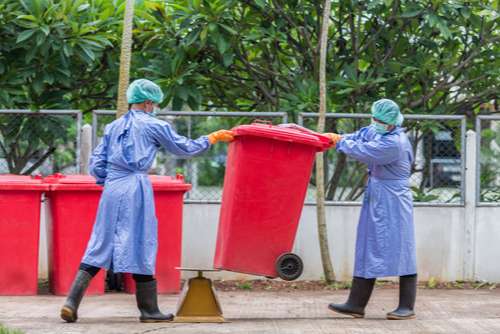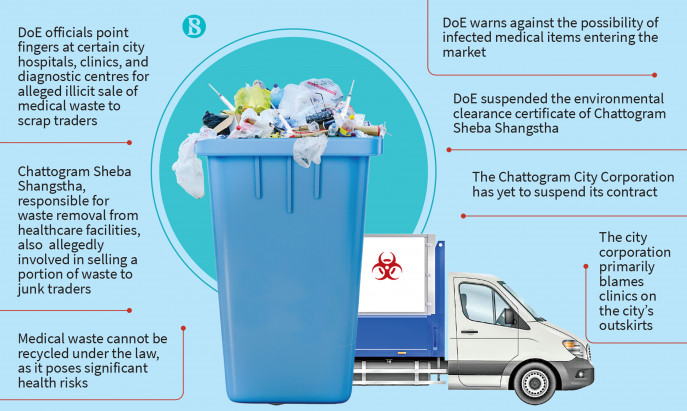Proactive Health Solutions: Selecting the Best Medical Waste Removal Near You
Wiki Article
Remain Ahead of Rules: Expert Recommendations on Medical Waste Disposal
In a world where the medical care sector is continuously progressing, it is critical for medical facilities to remain in advance of guidelines when it involves the correct disposal of medical waste. With strict guidelines and frequent regulative changes, it can be challenging to browse the complexities of this process. Nevertheless, with skilled recommendations, centers can ensure conformity and alleviate threats linked with inappropriate waste disposal. From understanding the various classifications of medical waste to implementing the best collection and segregation methods, this discussion will certainly offer valuable insights and actionable ideas to help facilities remain in advance of guidelines in the ever-changing landscape of clinical waste disposal.Understanding Medical Waste Categories
Comprehending medical waste classifications is essential for appropriate disposal and monitoring in healthcare centers. Clinical waste refers to any type of waste created by health care tasks that might pose a threat to public wellness or the atmosphere. It is essential to classify clinical waste properly to ensure its secure handling, disposal, therapy, and transportation.There are numerous categories of medical waste that healthcare centers need to be accustomed to. The most typical classifications consist of infectious waste, pathological waste, sharps waste, pharmaceutical waste, and chemical waste. Each classification has certain guidelines and regulations for its proper monitoring and disposal.
Contagious waste includes products polluted with blood or other bodily liquids, such as gloves, dress, and lab cultures. Pathological waste describes human tissues, organs, or body components that call for special delivery and disposal. Sharps waste includes used needles, syringes, and other sharp objects that can cause injury and transmit infections. Pharmaceutical waste makes up ended, extra, or polluted medicines that require cautious handling and disposal. Chemical waste includes solvents, disinfectants, and various other chemical compounds utilized in medical care facilities.
Remaining Up-To-Date With Regulatory Modifications
Staying present with regulatory changes is important for medical care facilities to make certain compliance and correct management of clinical waste disposal. medical waste removal near me. With regulations constantly advancing, it is vital for healthcare centers to remain updated to avoid charges, fines, and potential damage to the environment and public health and wellnessTo stay ahead of governing adjustments, medical care centers ought to establish a system for surveillance and monitoring updates. This can be done by subscribing to regulative newsletters, participating in workshops and seminars, and proactively getting involved in market associations. In addition, facilities must designate a personnel or group liable for remaining educated and disseminating information to appropriate stakeholders.
Regular interaction with regulative agencies is additionally crucial. Medical care centers should develop partnerships with neighborhood, state, and federal companies to ensure they are aware of any kind of changes in policies that might impact their waste monitoring practices. This can be done through regular meetings, engagement in public remark periods, and positive involvement with regulatory companies.
In addition, health care centers ought to consider partnering with waste administration firms that focus on clinical waste disposal (medical waste disposal services with WasteX). These business are usually well-versed in the current guidelines and can give assistance and support to make sure conformity
Applying Correct Collection and Partition Approaches
To effectively manage medical waste disposal, healthcare facilities must establish proper collection and partition approaches in conformity with governing standards. Applying these approaches makes sure the risk-free handling and disposal of possibly dangerous materials, protects the environment, and minimizes the threat of infections and injuries to health care workers and the public.
Correct collection and segregation approaches involve the use of assigned containers and classifying systems. Medical care centers ought to offer clearly classified containers for various kinds of medical waste, such as sharps, transmittable waste, pharmaceutical waste, and non-hazardous waste. These containers need to be color-coded and plainly marked to stay clear of complication and promote easy recognition.
Furthermore, healthcare centers must train their personnel on the appropriate treatments for gathering and segregating clinical waste. This includes educating them on the various sorts of waste, the appropriate containers to make use of, and the value of following standards and guidelines. Routine training sessions and refresher course programs should be performed to guarantee that personnel continue to be updated on ideal methods.
Additionally, medical care facilities need to establish a system for normal collection and disposal of medical waste. This might involve partnering with accredited waste management firms that specialize in clinical waste disposal. These firms will make certain that the collected waste is transported and thrown away in compliance with regulative needs.
Choosing the Right Disposal Techniques

Incineration is just one of one of the most typical and reliable approaches for throwing away particular kinds of clinical waste, such as pathological waste and sharps. It entails the regulated burning of waste at heats, lowering it to ash. Nonetheless, incineration can launch harmful pollutants right into the air and add to air contamination.

Other disposal techniques include chemical therapy, microwave treatment, and landfilling. Chemical therapy involves the usage of chemicals to disinfect and counteract the waste. Microwave treatment makes use of microwave energy to warmth and disinfect the waste. Landfilling entails burying the waste in a marked landfill location (medical waste disposal services with WasteX). Nevertheless, landfilling needs to be the last hope due medical waste disposal services with WasteX to the prospective risk of contamination to soil and groundwater.
Making Certain Conformity Via Documents and Training
After meticulously considering the appropriate disposal methods for medical waste, medical care facilities must ensure compliance with regulations and minimize ecological influence by applying efficient paperwork and training procedures. This step is crucial in maintaining a sustainable and safe environment for both medical care employees and the public.
Training is similarly important in guaranteeing conformity with policies. Health care workers that deal with medical waste should obtain ideal training on waste segregation, taking care of, and disposal treatments. This training must cover subjects such as the proper use of personal protective devices, recognition of different sorts of waste, and the appropriate disposal approaches for each and every waste category. By giving detailed training, health care centers can encourage their staff to make educated choices and reduce the threat of improper waste disposal.
Final Thought
Finally, staying ahead of regulations in clinical garbage disposal is vital for medical care facilities. medical waste removal near me. Understanding the various groups of medical waste, staying upgraded with regulative modifications, executing correct collection and segregation methods, selecting the suitable disposal techniques, and guaranteeing conformity with documents and training are all crucial actions. By complying with these standards, medical care organizations can properly get rid of and manage of clinical waste in a risk-free and accountable mannerFrom recognizing the various categories of clinical waste to executing the right collection and partition approaches, this discussion will certainly offer useful insights and actionable ideas to assist centers remain ahead of policies in the ever-changing landscape of clinical waste disposal. - medical waste disposal services with WasteX
The most common categories include transmittable waste, pathological waste, sharps waste, pharmaceutical waste, and chemical waste. Medical care centers must offer plainly classified containers for various kinds of medical waste, such as sharps, infectious waste, pharmaceutical waste, and non-hazardous waste. Health care centers need to develop a thorough system to videotape and track all elements of clinical waste disposal, see post consisting of types of waste generated, amounts, and disposal methods used. Healthcare workers who take care of clinical waste must obtain appropriate training on waste partition, managing, and disposal procedures.
Report this wiki page